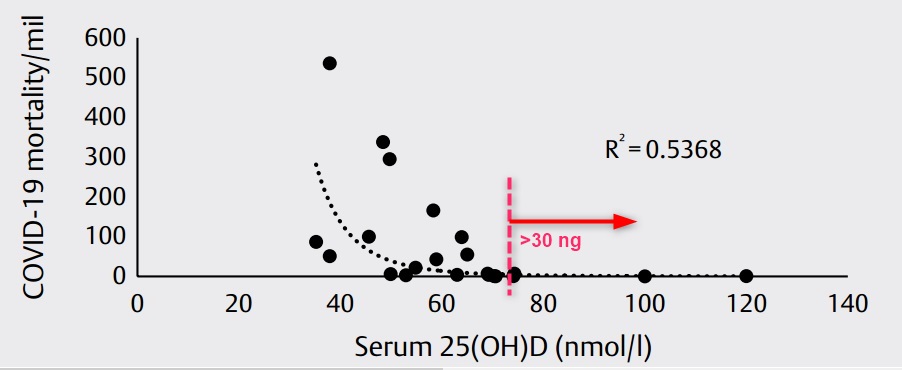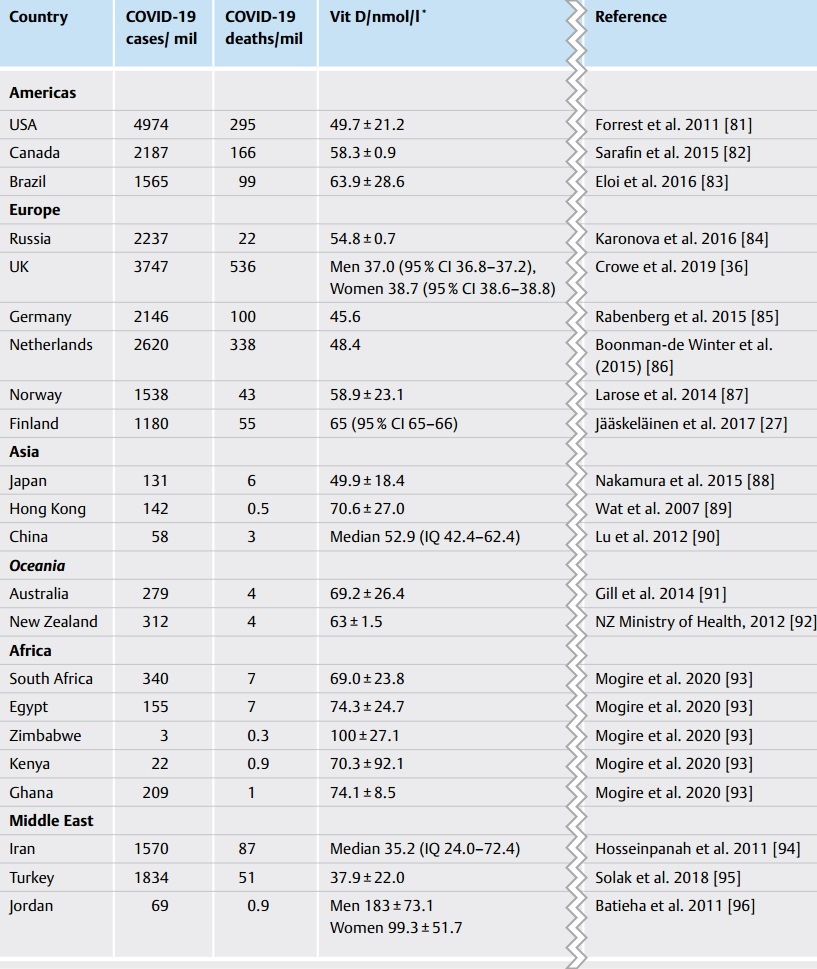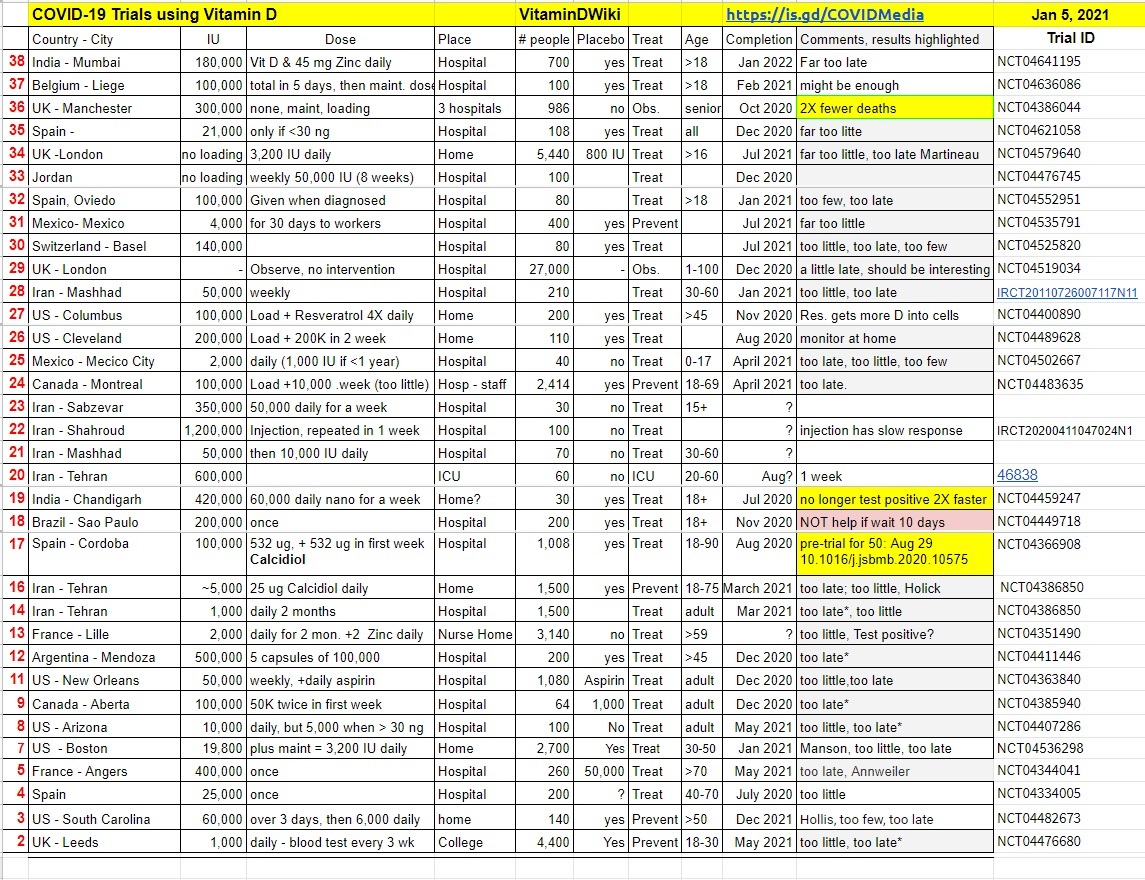Virtually no COVID-19 cases in countries having more than 30 ng of Vitamin D
Are Adequate Vitamin D Levels Helpful in Fighting COVID-19? A Look at the Evidence
Horm Metab Res. 2020 Sep 17. doi: 10.1055/a-1243-5462
Caroline Wei Shan Hoong # 1, Koh Huilin # 1, Sanda Cho 2,
Veeraraghavan Meyyur Aravamudan # 1,Jaime Hui Xian Lin # 1
Fewer deaths if higher D

Fewer cases if higher D

Data points

Mortality and case data from Worldometer as of May 23
 Click on chart for details
Recent updates on VitaminDWiki
Includes the RCT from Spain as of Sept 20
{include}
Click on chart for details
Recent updates on VitaminDWiki
Includes the RCT from Spain as of Sept 20
{include}
📄 Download the PDF from sci-hub via VitaminDWiki
COVID-19 is a global pandemic with high mortality in vulnerable groups. Given the current lack of definitive treatment or vaccine that significantly reduces mortality rate, governments, researchers and healthcare providers are racing to find possible solutions to the crisis. Vitamin D and its analogues have been previously studied for their non-skeletal benefits. In particular, questions regarding their role in the modulation of immunity have re-surfaced, in view of possible epidemiological links observed between COVID-19 and vitamin D levels in selected populations. In this review, we highlight potential mechanisms and summarise the evidence for and against the potential role of vitamin D supplementation in our fight against COVID-19.
References for the table
81) Forrest KYZ, Stuhldreher WL. Prevalence and correlates of vitamin D deficiency in US adults. Nutr Res 2011; 31: 48-54
Sarafin K, Durazo-Arvizu R, Tian L et al. Standardizing 25-hydroxyvita- min D values from the Canadian Health Measures Survey. Am J Clin Nutr 2015; 102: 1044-1050
Eloi M, Horvath DV, Szejnfeld VL et al. Vitamin D deficiency and seasonal variation over the years in Sao Paulo, Brazil. Osteoporos Int 2016; 27: 3449-3456
Karonova T, Andreeva A, Nikitina I et al. Prevalence of Vitamin D deficiency in the North-West region of Russia: A cross-sectional study. J Steroid Biochem Mol Biol 2016; 164: 230-234
Rabenberg M, Scheidt-Nave C, Busch MA et al. Vitamin D status among adults in Germany--results from the German Health Interview and Examination Survey for Adults (DEGS1). BMC Public Health 2015; 15: 641
LJM Boonman-de Winter, Albersen A, Mohrmann K et al. High prevalence of vitamin D deficiency in the south-west Netherlands. Ned Tijdschr Geneeskd 2015; 159: A8167
Larose TL, Chen Y, Camargo CA et al. Factors associated with vitamin D deficiency in a Norwegian population: the HUNT Study. J Epidemiol Community Health 2014; 68: 165-170
Nakamura K, Kitamura K, Takachi R et al. Impact of demographic, environmental, and lifestyle factors on vitamin D sufficiency in 9084 Japanese adults. Bone 2015; 74: 10-17
Wat WZM, Leung JYY, Tam S et al. Prevalence and impact of vitamin D insufficiency in southern Chinese adults. Ann Nutr Metab 2007; 51: 59-64
Lu H-K, Zhang Z, Ke Y-H et al. High prevalence of vitamin D insufficiency in China: Relationship with the levels of parathyroid hormone and markers of bone turnover. PLoS One 2012; 7: e47264
Gill TK, Hill CL, Shanahan EM et al. Vitamin D levels in an Australian population. BMC Public Health 2014; 14: 1001
Vitamin D. Status of New Zealand Adults [Internet]. Ministry of Health NZ. [cited 2020 May 26]
- Available from https://www.health.govt.nz/publication/vitamin-d-status-new-zealand-adults
Mogire RM, Mutua A, Kimita W et al. Prevalence of vitamin D deficiency in Africa: A systematic review and meta-analysis. Lancet Glob Health 2020; 8: e134-e142
Hosseinpanah F, Yarjanli M, Sheikholeslami F et al. Associations between vitamin D and cardiovascular outcomes; Tehran Lipid and Glucose Study. Atherosclerosis 2011; 218: 238-242
Solak I, Cihan FG, Mercan S et al. Evaluation of 25-Hydroxyvitamin D Levels in Central Anatolia, Turkey. Biomed Res Int 2018; 4076548
96) Batieha A, Khader Y, Jaddou H et al. Vitamin D status in Jordan: dress style and gender discrepancies. Ann Nutr Metab 2011; 58: 10-18
